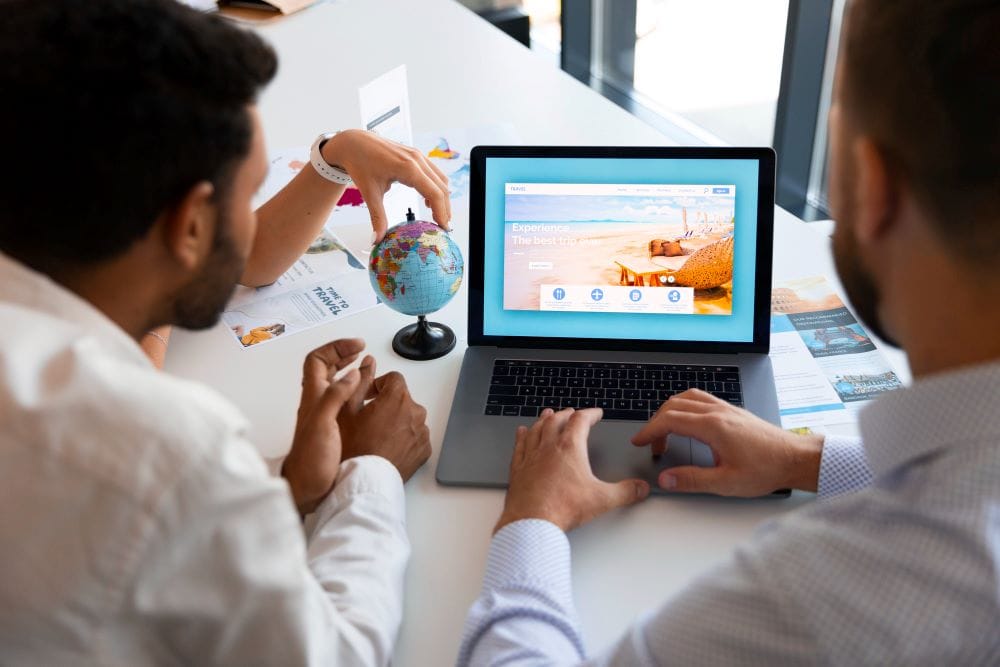Functionalities in a Tourism Industry
The tourism industry is a dynamic and multifaceted sector that significantly benefits from digital transformation. A well-designed tourism website is crucial for attracting and retaining visitors, providing information, and facilitating bookings. To achieve these goals, such a website must incorporate a range of functionalities tailored to the needs and expectations of travelers. Below is a detailed exploration of the key functionalities that a robust tourism industry website should feature.
Main Role of a Website in the Tourism Industry
User-Friendly Interface
A tourism website must have an intuitive and user-friendly interface. This includes a clean design, easy navigation, and accessibility features to ensure all users, including those with disabilities, can use the website effectively. Clear menus, well-organized content, and responsive design are essential to provide a seamless user experience across all devices, including desktops, tablets, and smartphones.
Comprehensive Destination Information
Providing detailed information about destinations is one of the core functionalities of a tourism website. This includes:
- Descriptions and Highlights: Information about landmarks, historical sites, cultural attractions, and natural wonders.
- Multimedia Content: High-quality images, videos, and virtual tours to give visitors a vivid sense of the destinations.
- Local Insights: Guides on local customs, traditions, and cultural practices.
- Maps and Directions: Interactive maps and detailed directions to help visitors navigate the destination.

Booking and Reservation Systems
A robust booking system is critical for converting website visitors into customers. This system should include:

- Accommodation Booking: Real-time availability and booking options for hotels, hostels, vacation rentals, and other lodging types.
- Flight Booking: Integration with airlines and travel agencies to allow users to search for and book flights.
- Activity and Tour Booking: Options to book tours, excursions, and activities at the destination.
- Car Rentals: Information and booking options for car rentals.
- Secure Payment Gateways: Multiple payment options, including credit cards, digital wallets, and bank transfers, with robust security measures to protect user data.
User Reviews and Ratings
User-generated content in the form of reviews and ratings can significantly influence prospective travelers’ decisions. A tourism website should:
- Allow Reviews and Ratings: Enable users to leave reviews and ratings for accommodations, attractions, and services.
- Moderation and Verification: Implement systems to verify the authenticity of reviews and moderate content to prevent abuse.
- Display Average Ratings: Show average ratings and highlight top-rated services and destinations.

Personalization and Recommendations
Personalization enhances the user experience by tailoring content and recommendations based on user preferences and behavior. This can include
- Customized Itineraries: Tools for users to create and customize their travel itineraries based on their interests and travel history.
- Personalized Recommendations: Suggesting destinations, activities, and accommodations based on user preferences and past behavior.
- User Profiles: Allowing users to create profiles to save their preferences, booking history, and itineraries.
Content Management System (CMS)
A flexible and powerful CMS is essential for managing the website’s content. This system should allow administrators to:
- Easily Update Content: Add, edit, and remove content without needing technical expertise.
- Manage Multimedia: Organize and manage images, videos, and other media assets.
- SEO Tools: Implement SEO best practices to improve the website's visibility on search engines.

Multilingual and Multicurrency Support
Catering to an international audience requires the website to support multiple languages and currencies. This functionality should include:
- Language Options: Translation of the website’s content into multiple languages.
- Currency Conversion: Display prices and process payments in various currencies.
- Localized Content: Tailoring content to different regions and cultures.
Customer Support and Chatbots
Providing excellent customer support is crucial for addressing user inquiries and issues. Features should include:
- Live Chat Support: Real-time assistance through live chat with customer support agents.
- Chatbots: Automated chatbots to handle common queries and provide instant responses.
- Contact Forms: Easy-to-use forms for users to submit inquiries and feedback.
- FAQ Section: A comprehensive FAQ section to address common questions and concerns.

Social Media Integration
Integrating social media allows for broader reach and engagement. This includes:
- Social Media Links: Easy access to the tourism company's social media profiles.
- Social Sharing Buttons: Enabling users to share content, itineraries, and reviews on their social media accounts.
- User-Generated Content: Encouraging users to share their travel experiences and photos, which can be featured on the website.


Blog and Travel Guides
A blog section can provide valuable content and improve SEO. This should include:
- Travel Tips and Advice: Articles on travel planning, packing, safety tips, and more.
- Destination Guides: In-depth guides on various destinations, including hidden gems and off- the-beaten-path locations.
- Guest Posts: Contributions from travel bloggers and influencers to offer diverse perspectives.

Events Calendar
An events calendar keeps users informed about upcoming events at their destination. Features should include:
- Event Listings: Detailed information about festivals, concerts, exhibitions, and other events.
- Ticket Booking: Options to purchase tickets for events directly through the website.
- Reminders and Alerts: Notifications and reminders for upcoming events.
Weather Information
Providing up-to-date weather information helps travelers plan their trips. This can include:
- Current Weather: Real-time weather conditions at various destinations
- Forecasts: Short-term and long-term weather forecasts.
- Weather Alerts: Notifications about severe weather conditions.

Travel Insurance
Offering travel insurance options directly on the website provides added convenience and peace of mind for travelers. This should include:
- Insurance Plans: Various travel insurance plans covering different aspects such as trip cancellation, medical emergencies, and lost luggage.
- Easy Purchase: Integration with insurance providers to allow users to purchase plans easily.
- Claims Information: Guidance on how to file claims and what is covered.
Loyalty Programs
Loyalty programs incentivize repeat business and customer retention. Features should include:
- Points System: Earning points for bookings, reviews, and referrals.
- Rewards and Discounts: Redeeming points for discounts, free services, and other rewards.
- Member-Exclusive Offers: Special deals and promotions for loyalty program members.

Analytics and Reporting
Analytics tools are essential for understanding user behavior and improving the website. This should include:
- Traffic Analysis: Monitoring website traffic and user engagement metrics.
- Conversion Tracking: Analyzing booking and reservation conversion rates.
- User Feedback: Collecting and analyzing user feedback to identify areas for improvement.
Security Features
Ensuring the security of user data and transactions is paramount. This includes:
- SSL Encryption: Secure Socket Layer (SSL) encryption to protect data transmission.
- Data Protection: Compliance with data protection regulations such as GDPR.
- Fraud Prevention: Measures to detect and prevent fraudulent activities.


Mobile App Integration
Many travelers prefer using mobile apps for planning and booking their trips. Features should include:
- Seamless Integration: Ensuring the website and mobile app provide a consistent user experience.
- Push Notifications: Sending updates and alerts to users via the app.
- Offline Access: Allowing users to access essential information even without an internet connection.
A comprehensive tourism industry website is more than just a digital brochure; it is a powerful tool that serves as a virtual travel agent, providing all the information and services travelers need to plan and book their trips. By incorporating these functionalities, a tourism website can enhance the user experience, increase engagement, and ultimately drive more bookings and revenue. As technology continues to evolve, staying updated with the latest trends and features will be crucial for maintaining a competitive edge in the tourism industry.
Why Choose Gazelle for Your Tourism Website?
Ready to Elevate Your Tourism Business Online?
Let Gazelle help you build a captivating website that attracts tourists, promotes your brand, and grows your bookings. Reach out to us today!
